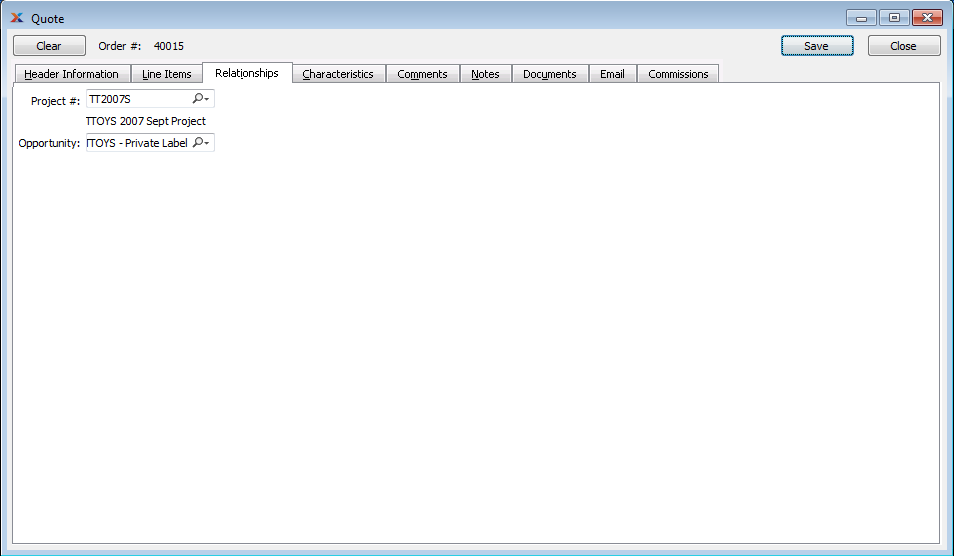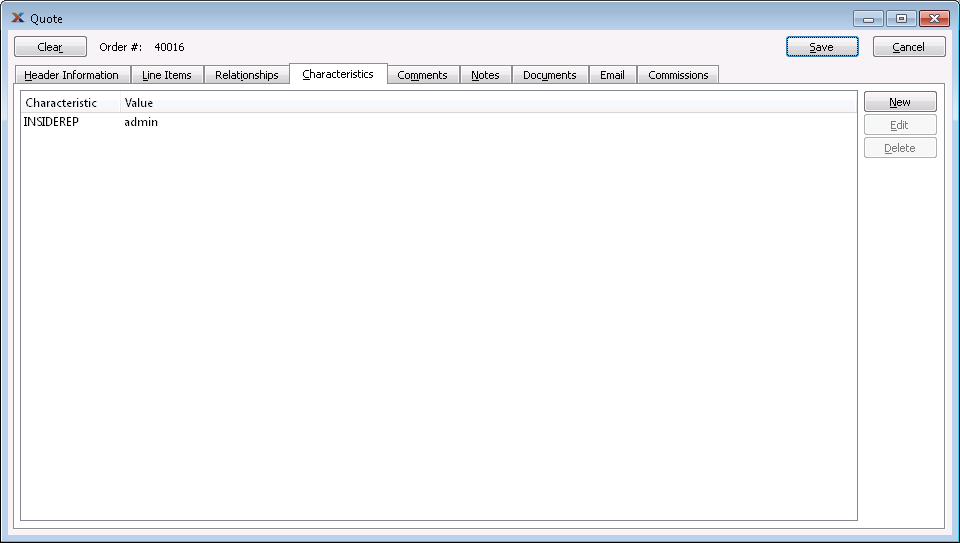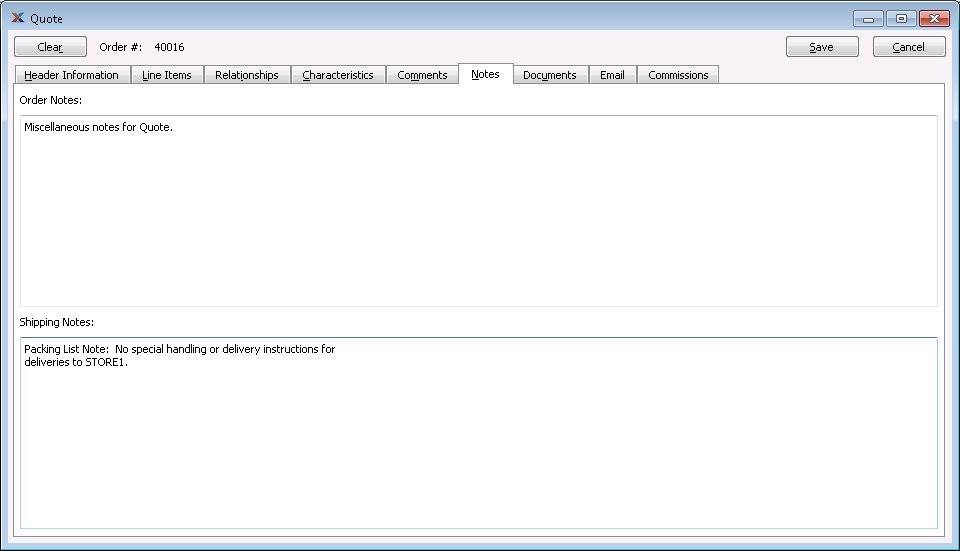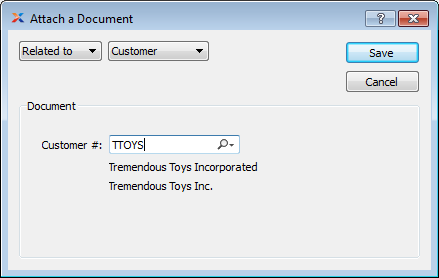
|
xTuple ERP Reference Guide |
A Quote is a statement issued to a Customer or Prospect indicating pricing and sales Terms for specified quantities of sold Items. Quotes are often precursors to Sales Orders. To create a Quote, select the "New Quote" option. The following screen will appear:

Be sure to close all Sales Order windows before exiting the system. This will prevent the creation of orphaned Sales Order records.
When creating a new Quote, you are presented with the following options:
Next available Quote Number will automatically display, unless your system requires you to enter Quote Numbers manually. Default values and input parameters for Quote Numbers are configurable at the system level.
Displays current day's date.
Displays the Order's earliest scheduled date. The scheduled date corresponds to the earliest scheduled date for an included Quote Item. If there are no existing Line Items, the date entered here will become the default schedule date for the first one. If Line Items do exist and the date is changed, you will be asked whether you want all editable lines to change. If the change affects pricing, you will be asked whether you want Prices to be updated as well. If hidden, this field can be viewed by selecting the MORE button.
The pack date is the same date as the ship date. Because the field can be edited, you have the ability to change the pack date and make it different from the ship date. This field can be viewed by selecting the MORE button.
Specify the billing Terms associated with the Order. By default, the Customer's standard billing Terms will appear in the field.
Specify the Sales Representative associated with the Order. Sales Representatives are linked to a Customer on the Customer master—either by a default setting or through the assignment of Ship-To Addresses. Each Ship-To Address may have a different Sales Representative associated with it. Consequently, the name of the Sales Representative appearing on the Quote header will be the same as specified for the Ship-To Address being used.
By default, the commission percentage recorded on the Customer master will be automatically entered in this field. If for some reason you select a non-default Sales Representative at Order entry, the commission rate will not change. To adjust the commission rate, you must make the change manually. This field can be viewed by selecting the MORE button.
Specify the Tax Zone associated with the Quote. The Tax Zone for the specified Ship-To Address will be entered here by default. Otherwise, the primary Tax Zone for the Customer will be entered. This field can be viewed upon selecting the MORE button.
Specify the shipping Site associated with the Quote. The Site selected here acts as the default free on board (FOB) location. A Site may be designated as a shipping Site on the Site master. This field can be viewed upon selecting the MORE button.
Specify the origin of the Quote using the options below. This field can be viewed upon selecting the MORE button.
Indicates the Order was originated by the Customer.
Indicates the Order was originated by an Internet lead.
Indicates the Order was originated by the Sales Representative.
Specify the Sales Type. Sales account assignments by Sales Type are available.
Select to automatically print the Quote when it is saved.
Displays the current status of the Quote. There are two possible values: open and converted. Quotes get the converted status after they have been converted to Sales Orders. If your Sales module is configured to show Quotes after they have been converted, you may view historical Quotes from the Customer Workbench. Converted Quotes will not be visible on the list of open Quotes.
Enter the date when the Quote expires, if any.
Enter the Customer Number of the Customer (or Prospect) to be billed for the sale. The lookup feature located to the right of the field leads to a searchable Customers list. The lookup feature will be disabled if the Quote is entered for a Prospect. You may also access the Customer list using the keyboard shortcut "CTRL + L". Once a Customer Number is entered, the Customer name and billing address will display. Select the "?" or "$" symbol to view Customer information for the specified Customer. If a Customer's credit is "In Good Standing," the button will feature a black question mark ("?") icon. If the icon turns to an orange dollar sign ("$"), the Customer's credit Status is "On Credit Warning." A red dollar sign ("$") indicates the Customer's credit Status is "On Credit Hold." You may also create a new Customer record by selecting the "+" button.
A valid Customer Number must be entered in the "Customer #" field before Line Items can be added to a Quote. If no valid Customer Number is entered, you will not be able to add Line Items to the Quote. Additionally, Quotes may only be entered for active Customers.
Quotes may not be entered for Customers whose credit status is either "On Credit Warning" or "On Credit Hold." Only users with special privileges may override these credit settings.
Displays the Customer's Bill-To name.
Displays the Customer's Bill-To phone number.
Displays the Customer's Bill-To Address. You may manually override the displayed Address information in the fields below—or use the lookup feature to select another Address. If a new Address is manually entered here, that Address will be added automatically to the master list of Addresses. For additional documentation related to creating Addresses, see Section 8.1, “ New Address”.
Select to copy contents of billing address into Ship-To address field. This option is enabled if the Customer master for the specified Customer indicates that free-form Ship-To's are allowed.
Enter the number of the preferred Ship-To Address. Customers may maintain multiple Ship-To Addresses. If the Customer master for the specified Customer indicates that free-form Ship-To's are allowed, then any address may be entered. If free-form Ship-To's are not allowed, then the Ship-To Address must be entered using the browse button located to the right of the field.
Displays the name for the specified Ship-To.
Displays the phone number for the specified Ship-To.
Displays the specified Ship-To Address. You may manually override the displayed Address information in the fields below—or use the lookup feature to select another Address. If a new Address is manually entered here, that Address will be added automatically to the master list of Addresses. For additional documentation related to creating Addresses, see Section 8.1, “ New Address”.
Enter free on board (FOB) Terms for the Order. By default, FOB. Terms entered on the Shipping Site master will appear in this field. The default Terms may be changed during Order entry—and also at later stages during the billing cycle.
PO #: Enter a Customer Purchase Order Number, as needed.
You will be required to enter a Customer Purchase Order Number for Customers who require them. If required, duplicate numbers will only be allowed if the Customer uses blanket Purchase Orders. All Customer requirements are specified on the Customer master.
The preferred Ship Via method for the Customer will appear in the field. You may change the default Ship Via using the list. You may also enter a free-form Ship Via simply by typing the name of the Ship Via into the field.
The system supports up-to-date shipment tracking with links to the websites of many leading shipping companies (i.e., "Ship Vias").
Specify the Shipping Zone. Sales account assignments by Shipping Zone are available.
Specify a hold type (if any) from the available options:
Indicates no hold is applied, meaning the Order may be processed and shipped.
Indicates the open balance for the Customer has exceeded the credit limit defined on their Customer master record. Users will be prevented from issuing Stock to Shipping with this hold type.
Indicates a Shipping hold has been placed on the Order. Users who attempt to ship an Order on Shipping hold will be prevented from doing so.
Indicates a Packing hold has been placed on the Order. Users who attempt to issue stock to Shipping for an Order on Packing hold will be prevented from doing so.
This hold type is set automatically when a Quote is created from a Return Authorization and the disposition requires Inventory to be received before the replacement Order can be shipped.
Specify the Shipping charges associated with the Order. The preferred Shipping Charges Type for the Customer will appear in the field. This field can be viewed upon selecting the MORE button.
Specify the Shipping Form associated with the Order. The preferred Shipping Form for the Customer will appear in the field. This field can be viewed upon selecting the MORE button.
Shipping defaults specified on the Customer master will transfer to the Quote header when a new Quote is entered for a Customer.
To create or modify Quote Line Items, select the "Line Items" tab at the top of the "New Quote" screen. The following screen will appear:

The system will allow you to enter Quotes for Items which do not have Item Sites. However, Item Sites must be defined before a Quote can be converted to a Sales Order.
When creating or modifying Quote Line Items, you are presented with the following options:
Display lists Line Items for this Quote. A valid Customer Number must be entered in the "Customer #" field before Line Items can be added to the Order.
Displays the total profit margin for the Quote. The profit margin is based on the following formula:
Quote Subtotal - Total Standard Costs for all Line Items
Displays the subtotal for the Quote Line Items.
Displays the amount of Tax that will be added to the Sales Order, as defined by the specified Tax Code. To get a detailed view of the Tax calculation, click on the Tax link using your mouse.
Enter the amount of any miscellaneous charge. Examples of miscellaneous charges include palletization costs, co-op refund, etc. Before entering a miscellaneous charge amount, you must first assign the charge to a Sales Account and also enter a description of the charge.
If you do not use Miscellaneous Charges at your site, you can hide these fields so they are not visible when entering Sales Orders. To do so, simply select the "Hide Misc. Charges" option in the system-level configuration.
Enter a description to identify the miscellaneous charge.
Enter a Sales Account to assign the miscellaneous charge to.
Displays the combined weight of all Quote Line Items. Freight weight represents the sum of an Item's product weight and packaging weight, both of which are defined on the Item master. The per unit freight weight multiplied by the quantity per gives you the Line Item freight weight. The sum of all Line Item freight weights is the combined weight for the Quote.
Enter the amount of freight charge to be added to the specified Order. Freight charges may be entered during the creation or modification of a Quote—or at the time of shipment.
Displays the total amount of the Quote.
Any Quote Line Item may be shipped—even if the Item or Item Site in question becomes inactive after the Quote has been created.
To define or maintain relationships for Quotes, select the "Relationships" tab. The following screen will appear:

When defining relationships for Quotes, you are presented with the following options:
If your site is configured to use Projects, select a Project Number to associate with the Quote. If a Sales Order is created from a converted Quote—and the Quote had a Project Number associated with it—then the Project Number from the originating Quote will automatically be entered here. Once a Project Number is associated with a Sales Order, any Work Orders or Purchase Orders created by the Sales Order demand will automatically be linked to the same Project Number as the Sales Order. In this way, Sales Orders, Work Orders, and Purchase Orders may be linked to the same Project.
If you have the xTuple Project Accounting package installed—and you link a Project to the Quote—transactions related to the Sales Order will include the Project Number as the final segment of affected G/L Account Numbers. Account Numbers related to the following transactions will include the Project Number as the final segment: Issue to Shipping, Return Stock, Ship Shipment, Recall Shipment, and Post Invoice.
If your site is configured to create Projects automatically whenever new Sales Orders or Quotes are entered, the Projects generated in this way will assume the number of the Sales Order or Quote which caused their creation.
Select an Opportunity to associate with the Quote, using the lookup feature located to the right of the field.
Quote Characteristics are user-defined definitions which may be used to provide additional layers of description about Quotes. These descriptions are static and not processed by the system, but are useful for informational purposes. To enter Characteristics associated with a Quote, select the "Characteristics" tab. The following screen will appear:

Quote Characteristics
When creating a new Quote Characteristic, you are presented with the following options:
Select a Characteristic from the list of Characteristics designated as being available for use as Quote Characteristics.
Enter a description for the Quote Characteristic.
To add Comments related to a Quote, select the "Comments" tab. The following screen will appear:

When adding or reviewing Comments, you are presented with the following options:
Select to display all Comments in the list in an expanded view which includes the entire text of each Comment. To edit a Comment, simply select the "Edit" link next to the Comment. That link will not be shown for Changelog Comments, which can't be edited. If the "Verbose Text" option is not selected, the Comment list will display only header level information for each Comment.
Display lists Comments related to the record.
The following buttons are available:
Opens screen for creating a new Comment.
Highlight a Comment and then select this button to reach a read-only view of the "Edit" screen.
Enables you to edit highlighted Comments—as long as the Comments are not "ChangeLog" Comments. ChangeLog Comments are system-generated and may not be edited. The edit screen is the same as that for creating a new Comment—except that when editing, the fields will contain Comment information. Double-clicking on a Comment will also bring you to the editing screen.
To enter a new Comment, select the NEW button. The following screen will appear:

Select a Comment Type from the drop-down list to classify the Comment. This is a required step. Comment Types may be system-defined (i.e., "ChangeLog" and "General") or user-defined, as described in Section 13.2.2, “Comment Types”. Once you have specified a Comment Type, begin typing your Comment in the main text area. The text area features word-wrapping and scroll-bar support for longer Comments.
The following buttons are unique to this screen:
Select to show the complete list (i.e., "thread") of Comments associated with the record. To hide the list, simply select the SHOW MORE button again. The Comment thread will show the most recent Comment first.
Order Notes added to a Quote are used for internal purposes only. To add Order Notes to a Quote, select the "Order Notes" tab at the top of the "New Quote" screen. The following screen will appear:

When adding Order Notes to a Quote, you are presented with the following options:
This is a scrolling text field with word-wrapping for entering general Notes related to the Quote. These Notes are for internal use only.
This is a scrolling text field with word-wrapping for entering shipping Notes related to the Quote. These Notes are for internal use only. Shipping Notes are drawn from the Customer master—specifically from the "Shipping Notes" tab on the Ship-To Address master. The Notes may vary depending on the Ship-To Address specified for the Quote. These Notes provide a mechanism for transferring shipping information from the Customer master to the Quote.
To associate documents with a Quote, select the "Documents" tab. The following screen will appear:

When associating documents, you are presented with the following options:
Select to create a new document and associate it with the current record. You may create the following document types:
Select to create a new Image association.
Select to create a new Incident and associate it.
Select to create a new To-Do and associate it.
Select to create a new Opportunity and associate it.
Select to create a new Project and associate it.
Enables you to edit associated documents. The edit screen is the same as that for creating a new document—except that when editing, the fields will contain document information. Double-clicking on a document will also bring you to the editing screen.
Highlight a document and then select this button to reach a read-only view of the "Edit" screen
Select to associate already-existing documents. The following document types may be attached: Contact, Account, Customer, Employee, File, Image, Incident, Item, Opportunity, Project, Purchase Order, Sales Order, Vendor, Web Site, Work Order.
Highlight a document and then select this button to remove the association.
To associate already-existing documents, select the ATTACH button. The following screen will appear:

When associating already-existing documents, you are presented with the following options:
Indicate how the document is related to the current record. The following relationship options are available: Related to, Parent of, Child of, Duplicate of.
Specify the kind of document you want to associate. The following document types may be attached: Contact, Account, Customer, Employee, File, Image, Incident, Item, Opportunity, Project, Purchase Order, Sales Order, Vendor, Web Site, Work Order. When associating Files, you will also be given the option to save the File to the database.
There is no file size restriction when saving Files to the database. However, excessively large files could cause storage and performance issues.
Use the lookup field to identify the specific document you want to attach. The data entry options will vary depending on the document type you select.